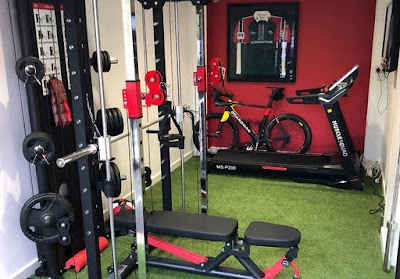For fitness enthusiasts and gym-goers, the squat rack is an indispensable piece of equipment that forms the cornerstone of strength training and muscle development. In this comprehensive guide, we'll delve into the world of squat racks, exploring their significance, various types, and the myriad benefits they offer to those seeking to elevate their workout routines.
What is a Squat Rack?
A squat rack is a robust fitness apparatus designed to support weightlifting exercises, particularly the squat. Its structure typically consists of vertical posts with horizontal safety bars, allowing users to secure a barbell at various heights for performing squats and other compound movements.
Key Features of Squat Racks:
Adjustable Height: Squat racks come with adjustable vertical posts, accommodating users of different heights and body types.
Safety Bars: Horizontal safety bars provide a safety net, preventing injuries by catching the barbell in case of fatigue or failed repetitions.
Versatility: Beyond squats, squat racks support a variety of exercises, including bench presses, overhead presses, and more.
Stability: Sturdy construction ensures stability, allowing users to lift heavy weights with confidence.
Benefits of Incorporating Squat Racks into Your Fitness Routine:
Full-Body Strength Development:
Squats, the primary exercise performed on squat racks, engage multiple muscle groups simultaneously. This compound movement targets the lower body, including quads, hamstrings, and glutes, as well as the core and lower back, promoting comprehensive strength development.
Improved Athletic Performance:
Squat racks contribute to improved athletic performance by enhancing strength, power, and functional movements. Athletes across various sports incorporate squat rack exercises to gain a competitive edge and boost overall performance.
Safety and Injury Prevention:
The safety bars of squat racks serve as a crucial safety feature. Users can lift heavy weights with the assurance that, in the event of fatigue or muscle failure, the safety bars will catch the barbell, preventing injuries and providing a controlled descent.
Efficient Time Management:
Squat racks allow users to perform compound exercises that target multiple muscle groups in a single session. This efficiency is especially beneficial for those with limited time for workouts, providing a time-effective solution for achieving comprehensive fitness goals.
Types of Squat Racks:
Power Racks:
Power racks, also known as power cages, are enclosed structures with four vertical posts, creating a secure space for lifting. They often include additional features such as pull-up bars, plate storage, and accessory attachments, offering a comprehensive strength training solution.
Half Racks:
Half racks are similar to power racks but with only two vertical posts. They provide an open design while still offering safety features like spotter arms, making them suitable for those with limited space.
Wall-Mounted Racks:
Ideal for space-conscious individuals, wall-mounted racks attach to the wall and can be folded away when not in use. While they may lack some features of larger racks, they provide a practical solution for home gyms with limited space.
Squat Stands:
Squat stands consist of two separate vertical posts without the additional structure of a power rack. While they offer a smaller footprint, users should use caution and consider safety features such as spotter arms.
Choosing the Right Squat Rack for Your Needs:
Space Availability:
Consider the available space in your home gym or workout area. Power racks and half racks may require more space, while wall-mounted racks or squat stands are more suitable for compact environments.
Budget Considerations:
Squat racks come in various price ranges. Determine your budget and explore options that offer the features you need without exceeding your financial constraints.
Features and Accessories:
Assess additional features such as pull-up bars, plate storage, and accessory attachments. Power racks often come with a range of add-ons that can enhance your workout variety.
Conclusion:
Incorporating a squat rack into your fitness routine is a transformative step toward achieving comprehensive strength, muscle development, and overall fitness. Whether you opt for a power rack, half rack, wall-mounted rack, or squat stand, the versatility and benefits of squat racks make them a valuable investment in your fitness journey.
